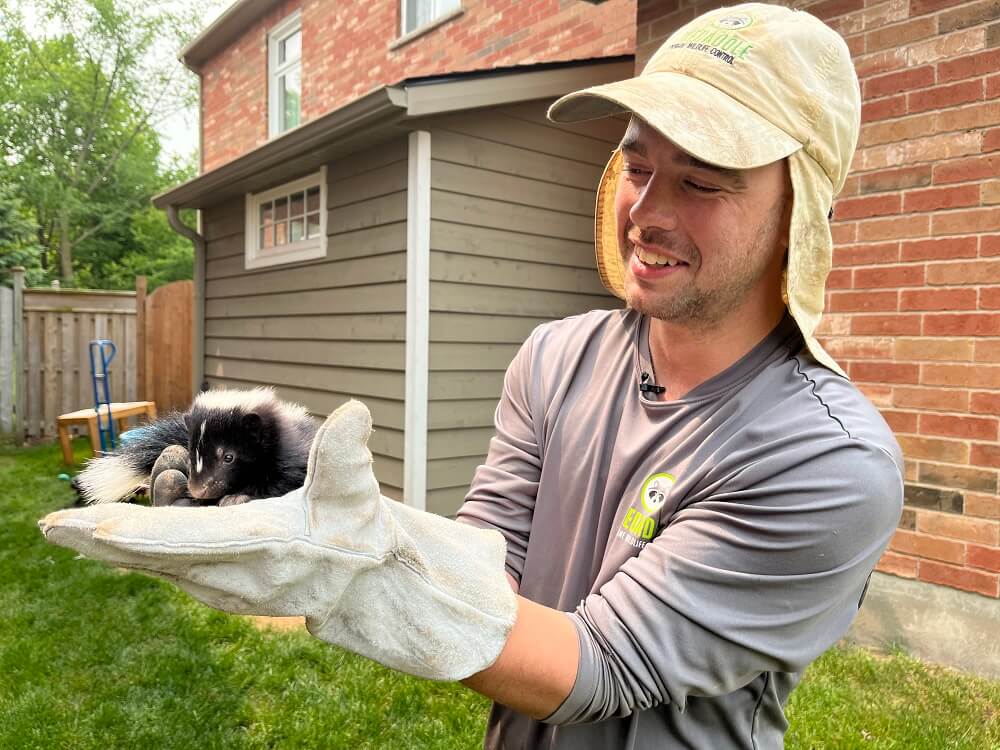SKUNK REMOVAL PROCESS
Assess and Remove
To solve a skunk problem, we start with a complete assessment of your property to determine where the skunks are living and how they’re gaining access. Since skunks do not climb our inspection will focus on the ground level den sites like porches, decks and sheds. We then perform a careful and humane removal, including any babies.
Clear and Clean
Once we humanely remove any skunks and their babies we will move on to clearing the den site of any damaged property, nesting material or debris that was gathered by the animals. We can then begin cleaning, disinfecting and deodorizing the area to eliminate any risk of illness, irritating odors and attractants for other wildlife.
Prevent and Protect
To prevent a future skunk problem, our technicians will get to work installing protective barriers designed to keep skunks out. This usually involves digging out around the perimeter of the deck, shed or porch and burying a heavy steel mesh deep into the ground. Our workmanship and materials are backed by a lifetime warranty.
Living with skunks in Hennepin County can be a smelly and frustrating experience. These creatures can take over your backyard, spray your pets and leave their musky scent lingering for days. If you’re dealing with a skunk problem, it’s important to know what steps to take to safely and humanely remove them from your property.
That’s where Skedaddle Humane Wildlife Control comes in. Their expert skunk removal in Hennepin County process is designed to eliminate your skunk problem while ensuring the safety of both you and the skunks. By using humane and effective methods, Skedaddle can quickly and efficiently remove any unwanted skunks from your property, allowing you to enjoy your backyard once again.

Skunks in Hennepin County
Hennepin County is an ideal landscape for skunks. As incredibly adaptable creatures, skunks use residential and commercial areas to find food sources and establish a denning location. Skunks often live in close proximity to a reliable water source. Hennepin County is scattered with lakes which means that every community in the area offers skunks everything they need to thrive. Areas such as Mound, Excelsior and Minnetonka which surround a group of lakes are particularly opportune locations for skunks
Skunks are docile creatures that are relatively harmless to humans. They are omnivores that eat everything from fruits and grains to small grubs and insects. They sleep during the day in burrows they dig in the ground, so you rarely come in contact with them outside of nighttime hours. One of the most commonly known facts about skunks is that they have special anal glands that allow them to spray a noxious odor when they feel threatened.
Many types of wildlife are deterred by urban development and leave the area as the city grows. Skunks, however, often thrive in suburban environments. They are nocturnal and prefer to avoid direct interactions with humans, but they associate people with easy sources of food and often take up residence inside homes and under decks.
Skunks typically live alone in their burrows unless they are raising young babies. When babies are involved, a mother skunk can get aggressive when she feels threatened. Surprising a skunk can be dangerous for you and your family, so it is best to get the animal off your property as soon as possible.
How Skunks Damage Property
Skunks typically build burrows under existing structures. They often den under front porches, back decks, fallen trees or large bushes. You rarely see skunks during the day because they are nocturnal, but you may wake up to strips of sod that have been pulled up out of your yard when the animals were looking for grubs the night before.
Skunks are also incredible diggers. They have sharp claws that can slice through almost any material, so you may find shredded pieces of fencing or vents around your property. If you aren’t aware of burrows the animals dig, you could also accidentally step in one and injure your foot or ankle.
Green spaces, forests and mature tree populations are found all throughout Hennepin County. These areas are often rich in insects, which attracts skunks to the area. This is why skunks find their way into backyards and gardens, leaving behind small holes in the ground. Rural areas like Medina and Rogers are ideal, however, skunks can still find adequate food in the backyard of a home in Bloomington or Plymouth.
Why You Should Be Wary of Skunks
Skunks are much more docile than most wild animals. Their quiet and shy nature may lead you to believe that the creatures are completely harmless, so you may not see why you need to remove them from your property. Unfortunately, skunks can cause problems other than property damage if you allow them to live around your home.
A skunk’s main form of defense is the odor it can spray. The animals have scent glands that allow them to release a terrible odor when they feel threatened. Even if you aren’t directly attacking the animals, skunks can release the smell if you startle them when you walk by the den. It takes days and sometimes weeks to fully get rid of the odor after you have been sprayed by a skunk, so keeping the animals off your property is the best way to avoid this issue.
Skunks also bite and claw. They are rarely aggressive but will become so if they need to protect their babies. Their claws and teeth carry dangerous bacteria that could lead to infection or spread diseases. Because of their claws and teeth, it’s never a good idea to attempt skunk removal on your own.
Skedaddle‘s Process for Humane Skunk Removal
Some people believe that trapping and relocating skunks is the best way to get them off of your property, but this method usually does more harm than good. When placed in an unfamiliar environment, skunks must find a new source of food and water as well as locate shelter quickly to survive. Instead of causing unnecessary distress, Skedaddle uses humane exclusion tactics to encourage the animals to move on with minimal prompting.
We started the removal process after locating the den and assessing the situation. We then place a one-way door at the entrance to the den so that the skunk can exit but cannot return to the burrow. If there are babies inside, we wait until the mother leaves in search of food and then we remove the kits by hand and place them in a warm reunification box. We place the box somewhere where the mother can easily access it and reunite with her babies.
The final step in the removal process is to secure your property against future skunk entry. This requires burying an exclusion screen under the soil inorder to prevent burrowing under the structure in the future. Our team only uses high-quality materials that will withstand Minnesota’s changing seasons and any chewing from potential nuisance wildlife visitors.

Contact Skedaddle for Skunk Removal in Hennepin County
If you’re looking for a humane solution to deal with skunks, Skedaddle Humane Wildlife Control is here to assist you. Our team of experts possesses the expertise and specialized tools required to safely remove skunks. Contact us today to schedule an appointment and resolve your skunk-related concerns in a responsible and effective manner.
Skunk Facts
FACT:
Skunks are immune to the venom of many snakes, including rattlesnakes and copperheads. They’re known to eat these snakes, making them a valuable asset to farmers and gardeners who want to keep snake populations under control.
FACT:
Skunks have extremely poor eyesight, and they are nearsighted. This means that they rely on their sense of smell to identify predators, locate food as well as to communicate with other skunks in the area.
FACT:
A skunk’s sulfuric spray has a range of up to 10 feet, and its odor can be detected up to 1.5 miles. It can take 10-14 days for a skunk’s spray sac to refill which leaves them defenseless. Skunks will only spray when they feel threatened.
FACT:
Skunks are omnivores, and the vast majority of their diet includes; plants, small animals and insects. Skunks often find their favorite foods in the backyards and gardens.
CHECK OUT OUR LATEST BLOGS
Maple Grove Skunk Removal: Are There Any Skunk Predators In Minnesota?
The Hooded Skunk: Understanding Its Distinctive Characteristics
Plymouth Wildlife Control: Is Your Garbage Attracting Skunks?





